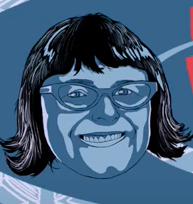Well! I’ve just discovered that Naughty Sophia was written by Winifred Mary Letts, who was born on 10 February 1882 in Broughton, Salford, and died in 1972!
A word to the wise – never put Naughty Sophia into a search engine without adding ‘children’s story’ first…
But, several pages of Italian dominatrices later, I’ve found the book! And discovered that the author was still alive and possibly only a few miles away when I read and fell in love with it! We never met, obviously, except in that mysterious way in which a reader meets a writer who will shape her life.
I can imagine my eight or nine-year-old, chronically shy self, learning that this writer who I loved lived near me. I would have been stunned by this information –. It was not, after all, beyond the bounds of possibility that I might bump into her in a shop. That single fact would have changed the geography of my world. It would have been like discovering that Snow White, or Little Red Riding Hood, or, possibly, the queen, lived down the road. Would I have dared to seek her out in her home in Salford, and would she have invited me in for tea and cake?
We will never know!
We do know in fact. Because Winifred Letts spent most of her life in Ireland and died there. But I prefer my imaginary scenario. How wonderful, she might have said, as I stood on her doorstep, speechless with trepidation, clutching my well-worn copy of Naughty Sophia. Come on in.
She was born, coincidentally, in the same two-week period as Virginia Woolf and James Joyce, two writers who subsequently shaped my imaginative world. What an epic fortnight that was for literature!
Now, here’s a question. There is one, slightly battered looking copy of Naughty Sophia available on Amazon for £29.83. I like the fact that it looks worn, reminding me of my old copy. Should I buy it and add it to my growing collection of slightly battered-looking and forgotten children’s books, or would that destroy the magic? I have, as an adult, re-read several books I loved as a child and found them preachy or sentimental; Heidi, Jo’s Boys, and the sequels to What Katy Did.
Why do I want it on my over-loaded shelves? Will anyone read it apart from me? A future granddaughter, perhaps, as much in love with reading as I was. Otherwise it is doomed to collect dust.
In any case, I can add her to my growing list of children’s authors who have lived in Manchester: Dodie Smith, Frances Hodgson Burnett, Gillian Avery, Angela Brazil. And I can contemplate the mysterious threads connecting the author who wrote the book I loved in 1912 to me, a girl growing up on a council estate in the 60’s and 70’s.
Timing is surely one of the most mysterious elements of the reading/writing process. Some books come out at the right time and catch fire, others flare briefly and fizzle out, while others sputter and gasp their way to oblivion. A book read at the right time will have a lasting impact on the reader, but how often have you lent a book to a friend who is unimpressed by it, or given up on a book that you enjoyed later (War and Peace took me thirty years and several false starts to get to grips with it, then I loved it) or returned to a book you loved once only to find it now leaves you substantially unmoved?
Marketing departments cannot reproduce the magic of a book being published or read at the right time – if they could they would have patented it by now. And they have even less control over the longevity of a book. They are possibly not even interested in it – their priority is the immediate hit.
Winifred Mary Letts was writing at the same time as L M Montgomery, another of my favourites, and Enid Blyton. She was born eight years after L M Montgomery and died thirty years later. She was fifteen years older than Enid Blyton but outlived her by 4 years.
So, here is my second question, which is one to which everyone in the whole of the bookselling world, writers, editors, agents and publicists would like an answer. Why did the work of Winifred Mary Letts not survive in the same way as these other authors, who are still famous today? She wrote, according to Wikipedia, 22 books, some plays and a considerable body of anti-war poetry.
Is it just a question of quality? Would it be obvious to me, if I ordered that single copy from Amazon, that Winifred Mary Letts was a writer of her time, unlike her two contemporaries? Although Enid Blyton’s prose has certainly dated. How many twelve-year olds do you know who will tell you that it is jolly bad form (to sneak, snitch or dob) before storming off to have a picnic? Interestingly, Blyton’s prose has dated, but not her stories.
Does it matter that we don’t know why Enid Blyton survived longer than Winifred Letts? It would surely be a mistake, if we ever worked out a formula for creating lasting fiction, to attempt to follow it.
Winifred Mary Letts would never know of my devotion, how secretly thrilled I was whenever I opened her book. Is this the real magic, and is the most important reward of all the one we never get?

